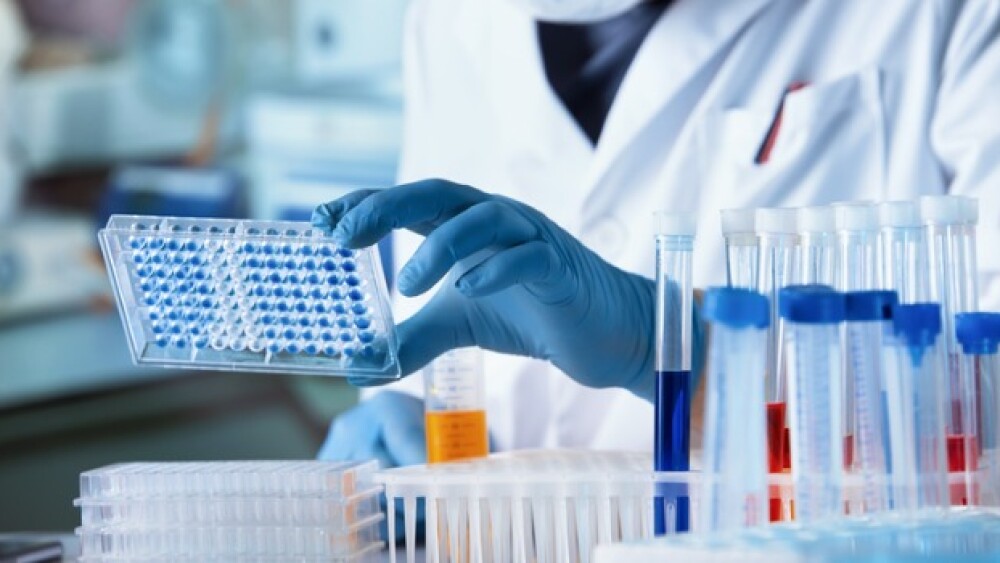Some experts question the value of recently issued FDA guidance that aims to address gaps in the quality of unapproved laboratory tests for cancer.
Pictured: A gloved hand holding a 96-well plate above a lab bench with other equipment/iStock, angelp
The FDA has established a voluntary pilot program intended to address the risks when targeted cancer treatments are approved without a companion diagnostic.
Companion diagnostic tests (CDx) analyze human samples for biomarkers to help match patients to specific treatments. Typically, the FDA will approve a CDx and a therapeutic product contemporaneously, but in some circumstances, a cancer therapy that requires the use of a CDx will be approved even if a corresponding test has not yet received marketing authorization.
In these cases, healthcare providers may use tests developed by laboratories—a laboratory developed test (LDT)—to make treatment decisions.
LDTs are intended to fill in the gap and are not necessarily regulated by the FDA in the same way as other in vitro diagnostics, Scott Danzis, partner and chair of the Medical Device Industry Group at Covington & Burling, told BioSpace.
As a result, the FDA said it has become “increasingly concerned” that some unauthorized LDTs may not provide reliable, accurate results, which can then negatively impact treatment decisions for cancer patients, the agency stated in a June 2023 press release announcing the pilot program. In 2015, the FDA published 20 case studies highlighting the potential dangers of unauthorized tests, including false negatives in detecting breast cancer and false positives in detecting ovarian cancer.
“Companion diagnostics are the only piece of information that a doctor and patient will get that will tell them whether they should take a particular targeted drug or not,” Liz Mansfield, vice president of regulatory policy at Foundation Medicine, told BioSpace. “You don’t want to get that wrong.”
Regulatory Ping Pong
The FDA has a long regulatory history with LDTs. The agency views the tests as medical devices under its regulatory purview but exercises “enforcement discretion,” meaning that the agency chooses not to enforce FDA requirements. As such, LDT manufacturers are not required to submit a test for FDA approval.
But Mansfield told BioSpace that without that regulatory oversight, quality comes into question. “There’s really no way of knowing if a test that hasn’t gone through FDA review is high quality or not,” she said.
LDTs are overseen by the Centers for Medicare and Medicaid Services through the Clinical Laboratory Improvement Amendments (CLIA). When developed without FDA clearance or approval, the CLIA requires labs to establish a test’s analytical validity—that is, how well it reflects what it is intended to measure—before results are released.
“There are certainly a lot of reasons to think that the system is working quite well,” Danzis said. He noted that laboratories are subject to federal and state regulation and go through a rigorous process of validation.
Although the CLIA requires that analytical validity be established, however, it does not require labs to establish clinical validity—how accurately a test identifies people with a specific clinical condition or risk. LDTs seeking FDA approval through the in vitro diagnostic pathway, on the other hand, must provide information about both analytical and clinical validity.
To address this regulatory gap, the newly announced pilot program will publish minimum performance characteristics recommended for LDTs that are not authorized by the FDA.
The regulator will request performance information for tests that were used to enroll patients in clinical trials testing subsequently approved therapies and then post to its website the minimum recommended performance characteristics for similar tests that could be used after approval. Laboratories creating LDTs will then be able to use the published characteristics to guide the development of such tests.
This transparency aims to help facilitate better and more consistent performance of LDTs, potentially resulting in better drug selection and improved care for patients with cancer, an FDA spokesperson told BioSpace in an email.
For now, the program is entirely voluntary, the FDA spokesperson noted. The agency is inviting participation and will accept no more than nine drug sponsors into the pilot program.
Experts Remain Skeptical
Mansfield expressed skepticism that the pilot program will be beneficial for the industry, noting that LDTs are still effectively unregulated even if companies participate.
“[The pilot program] is effectively legitimizing tests that FDA has never looked at,” she said. “The FDA actually won’t review any of the tests. It’s up to the test manufacturer or the laboratory to say, ‘Hey, we meet the minimum performance characteristics,’ but there’s no proof they actually do because FDA isn’t looking.”
The FDA representative confirmed via email that it will not perform its own evaluations of test performance and said test developers and drug sponsors gather those data through clinical trials. Collecting this type of data is outside the purview of the agency, the representative added.
“At Foundation Medicine, we create LDTs. We don’t have to go to the FDA, but we choose to do that to demonstrate that we are high quality,” Mansfield said. “We would like to benefit from that extra effort and not be put in a pool with every other test that claims to meet minimum performance criteria.”
Danzis took a more neutral stance on the pilot program. “I’m waiting to see where it goes and how successful it is,” he said. “I think recognizing the role that laboratories play in the diagnostic industry is a positive thing for the agency and for the healthcare system more broadly.”
He added that the question of regulating LDTs extends beyond the pilot program. “If FDA wants to regulate LDTs, my view has long been that the legislation should be enacted by Congress, giving [the regulator] that clear authority and developing a system that’s suited for the unique characteristics of laboratory diagnostics.”
Hayley Shasteen is a freelance science writer based in northeastern Ohio. You can reach her at hayleyshasteen@gmail.com, or follow her on LinkedIn.





